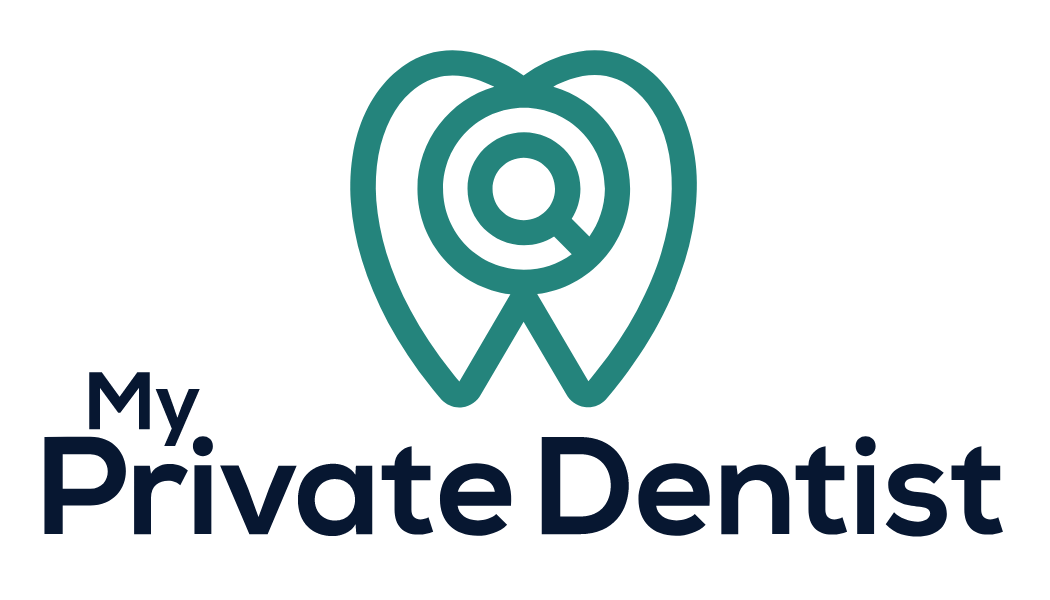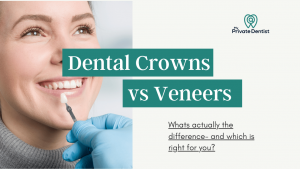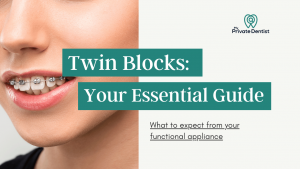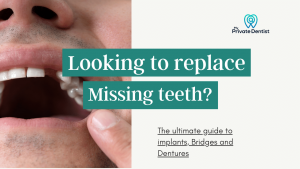These are my recommendations for choosing the best mouthwash for kids in 2024.
Getting kids to clean their teeth properly twice a day properly is no easy task. As a dentist and a dad, I recognise the challenge of encouraging good oral hygiene habits in my own children, as well as hundreds of children I have seen in my clinic over the years.
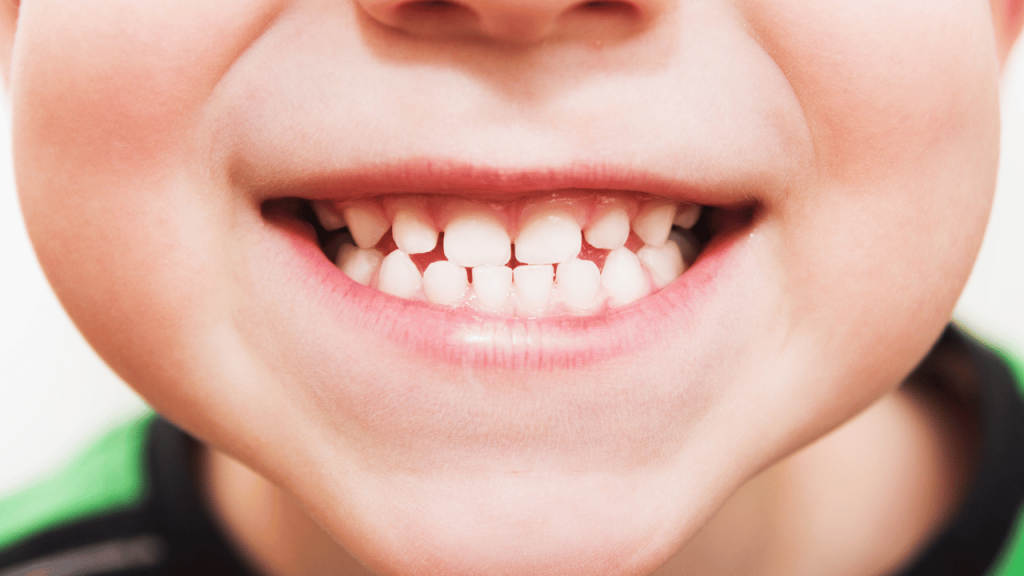
Adding a good mouthwash to your child’s routine, can actually make oral hygiene more exciting for them, whilst reaping the health benefits also.
As a dentist, I recommend Listerine Oral Smart Rinse as the best overall mouthwash for kids. Not only is it alcohol free and packed with fluoride to protect their teeth from cavities, but it also makes teeth cleaning more fun, by staining the plaque on their teeth (like a cool science experiment).
When it comes to picking a mouthwash for your little ones, there are some things to keep in mind. I’m here to give you the scoop on what matters, and what ingredients you should look for in a mouthwash to protect your kids’ teeth.
Let’s dive into our top picks for the best mouthwash for kids.
7 top picks
Best Overall Mouthwash for Kids – Listerine Smart Rinse
Best Tasting Mouthwash for Kids – Aquafresh Mouthwash for Kids
Best No-Mess Mouthwash for Kids – ACT Kids Mouthwash
Best Value-for-Money Mouthwash for Kids – Dentyl pH Mouthwash
Best Mouthwash for Kids with Braces – VITIS Orthodontic Mouthwash
Best Calcium Mouthwash for Kids – Fluor Kin Calcium Mouthwash
Best Eco-Friendly Mouthwash for Kids – Ecodenta Fluoride Free Mouthwash
Best Overall Mouthwash for Kids
Listerine Smart Rinse
Why our dentists recommend this mouthwash for kids:
Listerine Smart Rinse is hands down the best mouthwash for kids—it’s got all the essentials covered! It’s alcohol-free, so you can be confident it won’t sting or cause any discomfort. Plus, it’s got fluoride and xylitol, which are key ingredients for keeping little teeth strong and healthy.
A big plus, is that this mouthwash comes in four different flavours, catering to all kinds of taste buds. Instead of the usual minty options that can be too intense for some kids, they’ve gone with fun fruity flavours that are much more kid-friendly.
Now, here’s the real game-changer: this mouthwash can actually dye and disclose those pesky bad bacteria on the teeth. When your child uses it, the dental plaque and food debris get coloured by the mouthwash, making them more visible. So once they’ve brushed their teeth, they swish the mouthwash around for 60 seconds, then rinse it out. It reveals all the areas they might have missed while brushing.
The secret to a perfectly clean mouth? Simply go back over those areas with the toothbrush to remove the remaining plaque, and you’re good to go! It’s an awesome way to teach your kids about proper brushing technique and ensure their pearly whites are sparkling clean.
Pros
Helps highlight missed areas when brushing
Comes in a range of appealing flavours for kids to enjoy
Cons
Disclosing dye may stain braces if plaque build up on them
Best Tasting Mouthwash For Kids
Aquafresh Mouthwash for Kids
Why our dentists recommend this mouthwash for kids:
I decided to get this mouthwash for my six-year-old son, and it has become a staple in his night time routine.
The flavour was a real winner! The sweetness really shines through, making it so much easier to get my little one on board with the whole mouthwash routine.
Now, I do need to lend a hand and assist him while he’s using it. It’s important for parents to supervise their children during the mouthwash process to ensure they don’t swallow it accidentally.
One thing to note, though, is that this mouthwash is artificially sweetened and doesn’t contain xylitol. Just something to keep in mind if you’re looking for a xylitol-based option.
Pros
Great natural flavour
Cons
Dosage on the lid is hard to read.
Not Anti-Spill.
Best No-Mess Mouthwash
ACT Kids Anti-Cavity Fluoride Rinse
Why our dentists recommend this mouthwash for kids:
This mouthwash has been specifically designed with kids in mind. The bottle features a clever dosimeter which fills up as you squeeze it, ensuring your child gets just the right amount to rinse with. No spills and no excess usage.
They’ve been creative with the 4 flavours: pineapple, grape, watermelon and bubblegum. Having such a variety of options is a fantastic way to encourage kids to actually use the mouthwash.
ACT Kids is alcohol-free, so no stinging, just a gentle and safe experience. Plus, it contains fluoride for cavity protection. Studies suggest that with a good brushing technique, using a mouthwash with 0.05% fluoride can give children enamel that’s four times stronger.
Pros
Dosimeter makes it very easy for children to use, with no waste or spills
Cons
Doesn’t disclose plaque
Best Value Mouthwash for Kids
Dentyl Fresh Protect CPC Mouthwash
Why our dentists recommend this mouthwash for kids:
While most of the mouthwashes on our list are specifically designed for children, this particular one is suitable for both adults and kids alike.
What makes it even more appealing is its affordable price tag. It’s the lowest priced mouthwash among the ones we reviewed, and if parents can use it too, it becomes even more cost-effective!
This mouthwash covers all the essentials. It contains fluoride at child-friendly levels, ensuring effective cavity protection. It also includes xylitol and is alcohol-free, using Cetylpyridinium Chloride (CPC) instead to prevent any stinging or drying effects.
An interesting feature: When you spit it out, you can actually see what’s been cleaned away (although we understand this may not be for everyone!). It gives you that satisfaction of knowing it’s working. Additionally, kids will have have fun shaking the bottle before they start using it, as it mixes the oil-based and water-based components together.
Unfortunately, it only comes in minty flavours, which prevents it from taking the top spot as our best overall pick. It also has a standard bottle design and lacks a disclosing feature, which is why it falls behind the Smart Rinse in our rankings.
Pros
Cavity Protection from fluoride
Budget friendly
Suitable for the whole family
No Sting
Cons
Doesn’t disclose plaque
No mint flavour alternatives
Best mouthwash for kids with Braces
Vitis Orthodontic Mouthwash
Why our dentists recommend this mouthwash for kids:
For kids wearing braces, incorporating a daily mouthwash into their oral care routine becomes even more important. While brushing carefully around brackets is effective, mouthwash can provide additional benefits in removing stubborn food particles that may be trapped around the wires.
This specific mouthwash is formulated with key ingredients that target common issues associated with braces. Firstly, fluoride helps to keep enamel strong and prevent demineralisation and decay around brackets, caused by poor cleaning and a high sugar diet. Additionally, the presence of Allantoin aids in promoting the healing of sore spots or ulcers that can be caused by brackets or wires digging in. Aloe Vera has soothing properties, which can help to relieve gum soreness, and Cetylpyridinium Chloride (CPC) at a concentration of 0.05% is antibacterial.
Pros
More refined apple mint flavour
Soothing to sore gums, and promotes healing of sores caused by braces
Cons
Suitable for older kids (12+)
Best Calcium mouthwash for kids
Fluor Kin Calcium Mouthwash
Why our dentists recommend this mouthwash for kids:
In addition to fluoride and xylitol, calcium is another fantastic ingredient that can help protect children’s teeth. As found in milk and cheese, calcium in Fluor Kin mouthwash releases calcium ions to help rebuild and strengthen tooth structure.
It’s got the essential ingredients you need for a good quality kids mouthwash, with a sleek appearance. This mouthwash comes in a delightful strawberry flavour that can make your child’s oral hygiene routine feel like a tasty upgrade.
Pros
Strawberry Flavour
Added Calcium protection
Cons
More expensive than other options
No Dosimeter
No Disclosing
Best Fluoride Free mouthwash for Kids
Ecodenta Fluoride Free Mouthwash
Why our dentists recommend this mouthwash for kids:
If you’re concerned about your child ingesting fluoride, this mouthwash provides a fluoride-free alternative. This can be particularly relevant if your child is already using a fluoride toothpaste, as they are still receiving the necessary fluoride protection for their teeth.
This mouthwash is formulated with natural oils of coconut and aloe vera, both of which are known for their soothing properties on gums. These ingredients help provide a gentle and calming effect during rinsing.
Unlike the fruity flavours found in other mouthwashes, this option offers a more refined flavour profile. It has a mild sweetness that appeals to those who prefer a less intense taste experience.
Pros
Soothing
Fresh Breath
Dosing bottle
Cons
Not anti cavity
A Buying Guide For The Best Mouthwash For Kids
When it comes to picking the best mouthwash for kids, there are a few things to keep in mind:
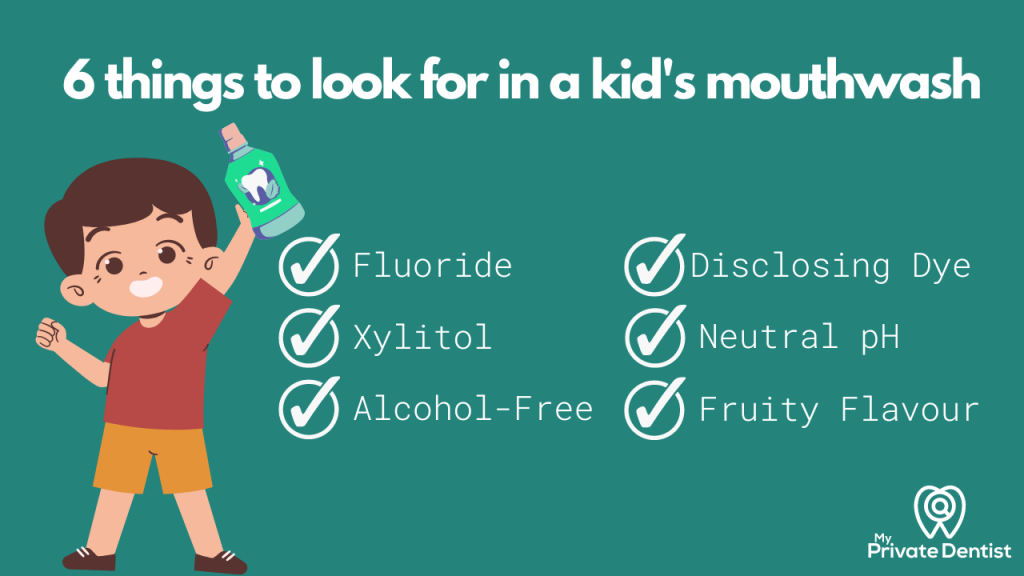
Fluoride Content for Cavity Protection
In my view, fluoride is the most crucial ingredient in a kids’ mouthwash.
Fluoride works in the mouth to remineralise and strengthen the outer enamel layer of teeth. Children’s teeth have very thin enamel, and so more at risk of developing cavities. Studies have shown that the addition of fluoride in mouthwash can effectively reduce cavities and tooth decay in children.
While the topical application of fluoride in mouthwash is beneficial in small amounts, care should be taken to make sure that your child doesn’t swallow it. If you’re worried about your child swallowing mouthwash, consider a fluoride-free option until you are confident that they can use it safely.
The recommended mouthwashes for kids typically contain 0.05% fluoride (225 ppm) and can be used daily as part of their oral hygiene routine.
It’s worth noting that if you live in an area with water fluoridation, it may be less necessary to include a fluoride mouthwash in your child’s routine.
Remember, it’s always a good idea to consult with your dentist to consider the most appropriate oral care regimen for your child, taking into account their specific needs and risk of developing tooth decay, as well as the local fluoride conditions
Xylitol
Xylitol, a natural sweetener, offers two significant advantages when included in mouthwash: improved taste, and decay prevention.
Xylitol improves the overall flavor of the mouthwash, making it more enjoyable to use, all without the addition of sugar or artificial sweeteners. This helps to make the mouthwash more palatable, especially for kids who may be sensitive to strong or unpleasant tastes.
It also plays a role in preventing tooth decay. Xylitol creates a protective barrier on the tooth surfaces, making it difficult for food particles and harmful bacteria to stick to the teeth. This reduces the risk of plaque formation and development of cavities.
Alcohol Free Formula
When it comes to mouthwash for kids, only opt for alcohol-free varieties.
Alcohol, known for its potent disinfectant properties, is commonly found in adult mouthwashes. However, it is not suitable for children’s mouthwash due to its potential to cause a burning sensation, which most children would find unpleasant.
In addition, alcohol-based mouthwashes can disrupt the delicate balance of oral bacteria. Using them may cause symptoms of dry mouth,which can actually make bad breath worse.
As a dentist, I generally recommend alcohol-free mouthwash for children and adults too.
Rather than alcohol, look for a more gentle ingredient called Cetylpyridinium Chloride (CPC) in mouthwash. This dissolves and removes bacteria and food debris, resulting in fresher breath.
Disclosing Properties
Where possible, consider a kids’ mouthwash with disclosing properties. As a dentist, I feel this feature is particularly useful for children who will not only enjoy using it, but if also learn to improve their oral cleaning technique.
In the dental practice, dentists commonly use disclosing tablets to educate patients on brushing. Patients chew on a small purple tablet, which dyes the plaque on their teeth, clearly showing up areas that were missed when brushing.
A mouthwash that contains a similar disclosing agent can do the same.
It can be used before brushing, to show your child exactly where and how well you need to brush. Alternatively you could ask your child to brush, and then use the mouthwash after. If any colour shows up on their teeth, then these are the areas that need a bit more attention.
Neutral pH
The pH (or acidity levels) of the food and drinks your child consumes has a big impact on the health of their teeth. Having low pH (or acidic) foods can potentially erode enamel, and leading to tooth wear, cavities and sensitivity.
That’s why it’s important to pick a mouthwash with a more neutral or slightly alkaline pH. It works to buffer saliva and neutralise the acid in their mouth, acting as a shield against an acid attack.
Neutral or alkaline pH mouthwashes are much kinder to tooth tissue than acidic ones.
Great Flavour Options
The traditionally minty flavour of mouthwash, although popular with adults, is almost universally disliked by children. They can find it too strong and ‘spicy’.
Bubble gum is a popular flavour we’ve come across in lots of mouthwashes for kids, and reviews show it’s well liked among children.
Some manufacturers have really gone the extra mile to cater to the tastes of children by incorporating fruity flavours such as berries, watermelons and pineapple. Surely, from among all these choices, you’re sure to find one your child will love.
Great flavour usually leads to better compliance, and consistently using mouthwash as part of their daily routinecontributes to a reduction in dental problems.
By selecting a mouthwash with a flavour that your child will enjoy, you help to encourage positive oral hygiene habits from an early age.
Advantages of using mouthwash for Kids
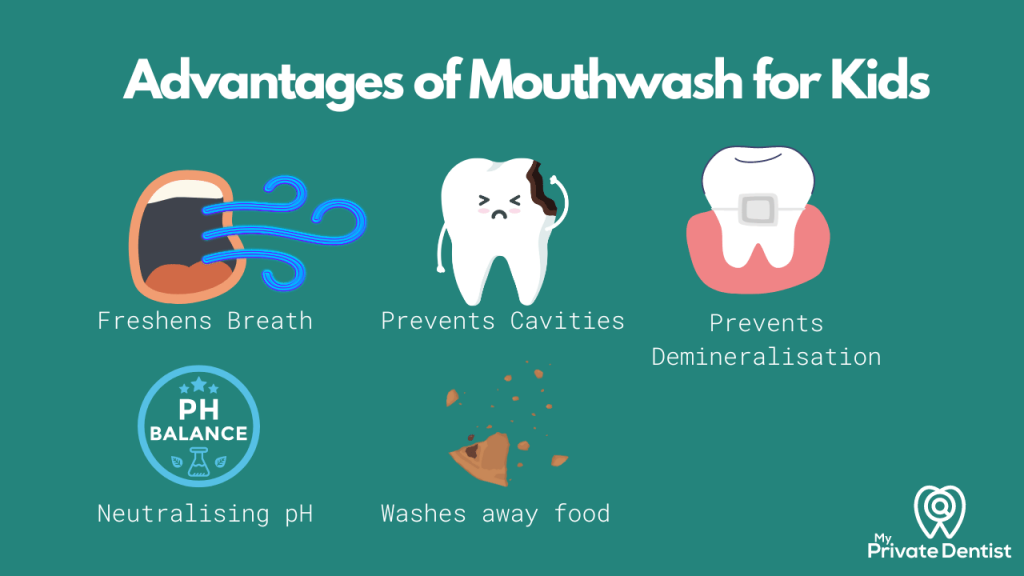
Fresh breath
Some parents report that their child’s breath smells despite them brushing well twice a day. There can be multiple causes of bad breath in adults and children, including bacteria present on the tongue, and food stagnation.
Many parents have found incorporating a mouthwash into their routine can help their child’s breath to feel fresher. This is due to more food, plaque and bacteria being washed away from the mouth.
Prevent cavities
The presence of the active ingredients fluoride, xylitol and calcium in mouthwash all help to prevent cavities. They help to strengthen the surface of the enamel and encourage remineralisation. However, mouthwash alone will not prevent cavities, and a regular and effective brushing regime alongside a low sugar diet is vital in preventing dental decay.
Less chance of white spots after braces
When a child has braces, an orthodontist will often advise the use of a fluoride rinse to help prevent demineralisation around brackets. This is when the enamel breaks down and appears frosted, or with brown marks around the bracket margins.
The mouthwashes that are recommended contain 0.05% Sodium Fluoride (225ppm) and should be used daily.
Neutralise pH to prevent tooth surface loss
Acidic foods and drinks reduce the pH levels in our mouth, which can lead to enamel wear and cavities. Alkaline or neutral mouthwashes (at a higher pH level), negates the effect by balancing out the pH.
Get rid of sugary plaque and foods
Swishing and rinsing the mouth with water after snacking can be a helpful habit for children to prevent food particles from lingering on their teeth. This practice can minimise the amount of time that food stays in contact with the tooth surfaces, reducing the risk of tooth decay.
Using a mouthwash instead of water can provide additional benefits, particularly if it contains fluoride and helps to neutralise the pH of the mouth.
Tips for using mouthwash
Start very small and build up
Getting children into good habits is a challenge for all parents. Studies have found that doing something daily for around 21 days can help turn actions into habits.
Start with using around 5-10ml, and talk your child through the process. At first, they may struggle to rinse for a full 60 seconds, but they will be able to slowly build up to that. Make the process as exciting as you can to get them enthusiastic about using mouthwash.
Get kids to rinse thoroughly
Using an egg timer or the stopwatch on your phone you can challenge children to reach the magic minute mark of swishing. The longer they keep the mouthwash in, for the better the results.
It’s also advised best to not eat or drink for 30 minutes after using mouthwash to get the full effects.
Always supervise children using mouthwash
Mouthwash is only recommended for children over 6 years old.
Until the age of 6, it’s important to supervise and assist children while they brush their teeth to ensure they are using the correct technique and not swallowing toothpaste. This supervision should continue when they start using mouthwash.
Some mouthwashes are designed to have a pleasant taste to encourage children to use them. However, it’s crucial to emphasise to children that mouthwash is not meant to be swallowed. Reinforce the importance of swishing and rinsing the mouthwash thoroughly and spitting it out, rather than swallowing it.
Most of the bottles above come with safety caps to avoid accidents, but it’s important that any fluoride continuing mouthwash is strictly swished and rinsed out, and not swallowed. Swallowing excessive amounts of fluoride can lead to fluorosis, a cosmetic condition that affects tooth enamel.
If your child has swallowed mouthwash it is important best to seek medical attention as soon as possible. Common symptoms of ingestion include diarrhoea, nausea, shortness of breath and vomiting.
Store mouthwash out of reach
The bottles are made to be appealing to get kids into good habits, but you want to keep them in a cool dry place out of reach, to prevent the temptation of using the mouthwash more often than they should.
Use at different time to brushing
Ideally, it is recommended to use mouthwash at a different time than brushing to allow the benefits of toothpaste to continue working. The fluoride in toothpaste needs some time to interact with the teeth and provide protection against tooth decay.
However, incorporating mouthwash into a separate time slot from brushing can be challenging for many people due to their daily routines. In such cases, using mouthwash immediately after brushing is still beneficial compared to not using it at all.
While using mouthwash right after brushing may rinse away some of the benefits of toothpaste, it can still provide additional oral hygiene benefits on its own. Mouthwash can help to remove bacteria, freshen breath, and reach areas that may have been missed during brushing. It can be a valuable tool in maintaining good oral health, especially when used alongside proper brushing and flossing techniques.
FAQs
How often should kids use mouthwash?
Ideally, kids should use mouthwash twice a day to swish away food debris, neutralise the pH of their mouth, and provide fluoride for remineralisation.
How can you teach kids to use mouthwash?
Get them to watch themselves in the mirror and see the funny faces they make. This will make them keep the mouthwash in for longer. The designs on the bottle and the fruity flavours can also help. Start with a very small amount (less than 10 ml) and try for 10-15 seconds, then build up from there.
Is mouthwash dangerous for kids?
Most ingredients in mouthwash are harmless, but it is designed to be swished and rinsed with and not swallowed. Small amounts of fluoride in the rinse help, but they should not be ingested or swallowed. Keep mouthwash out of reach and supervise your children when using it.
What is the minimum age for using mouthwash?
Mouthwash is for children 6 years old and up only. At this age, children have developed the necessary skills to rinse and spit out the mouthwash without swallowing it. Younger children may have difficulty properly using mouthwash and may be more prone to swallowing it,
Is fluoride safe?
Fluoride is safe when used appropriately. As a dentist I highly recommend fluoride in toothpaste as it plays a vital role in keeping teeth strong and preventing tooth decay.
When it comes to fluoride in mouthwash, it is also considered safe when used in small amounts and applied topically. However, it’s important to avoid swallowing mouthwash or any fluoride-containing products. Ingesting excessive amounts of fluoride can have adverse effects, so it’s crucial to follow the recommended usage guidelines and supervise children to ensure they spit out the mouthwash after rinsing.
Can kids use adult mouthwash?
Children should not use adult mouthwash. Adult mouthwashes often contain ingredients like alcohol, hydrogen peroxide, higher levels of fluoride, or chlorhexidine, which are not suitable for children. These ingredients can be potentially harmful or cause discomfort for young ones. Therefore, it’s best to stick to mouthwashes specifically formulated for children, which have age-appropriate ingredients and dosage levels.
Our Verdict
Adding a good mouthwash to your child’s oral hygiene routine can bring health benefits and some added fun.
The mouthwash we recommend is the Listerine Kids Smart Rinse. It’s effective, engaging , and gives your little one’s oral care routine an extra boost.
We love that it helps children to improve their brushing technique with its’ disclosing feature. It is also alcohol-free, has a balanced pH, contains fluoride for cavity prediction, and comes in four kid friendly flavours.
